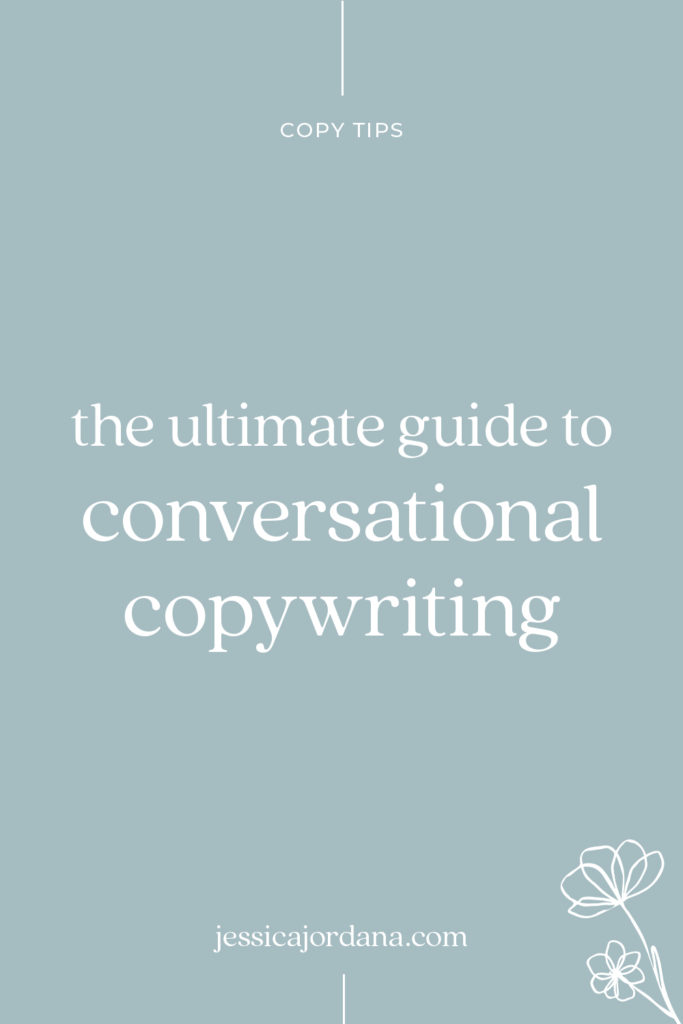The Ultimate Guide to Writing Conversational Copy
September 30, 2020
There are so many *shoulds* in life—especially in business.
“I should do the dishes before I go to bed.”
“I should create another program in my down time.”
“I should start a podcast or a YouTube channel… or both?!”
“I should ease up on my iced coffee habit.”
(LOL, just kidding. Don’t let anyone ever bring that negativity into your life. You savor every sip of that liquid gold, girl.)

This is just a taste of all the *shoulds* we’re faced with daily, whether it be on Instagram, in the magazines you read in the checkout line, or maybe even in the last blog post you read… like this one. 😉
Here’s the thing: With all of the *shoulds* shoved in our faces every day, you have to pick and choose the SHOULDS that you can feasibly turn into consistent CAN DOs, both in your life and your business.
There are especially a lot of *shoulds* in the world of copywriting
I’ve seen the shoulds and best practices in copywriting change connnnstantly over the last 3+ years.
“You should write for search engines to boost your SEO.”
“You should write with impeccable grammar at all times.”
“Just kidding, you can actually break the grammar rules here and there. But only these ones.”
“Andddd while you’re at it, forget about what we said about writing robotically for search engines. You should totes write for humans instead.”
OOF. THE MADNESS. Is your head spinning yet with all the back-and-forth, this-and-that nonsense? I know mine was for the longest time. 🥴
But if there’s one *should* that actually felt right for not only me, but for my clients and TPS Students to implement into their copywriting techniques, it’s this…
Conversational Copywriting is the KEY to having web copy that connects long before it converts
Conversational copywriting is an absolute game changer when it comes to having web copy that connects with your ideal client first, then converts them into your ACTUAL clients.
You may be wondering, “What exactly is conversational copywriting? It can’t be as simple as writing conversationally, like you would when you’re talking with a friend?”
Hey! Look at that. Turns out you know exactly what conversational copywriting is! Don’t overthink it—it is exactly what it is.
But, let’s be real. I know writing conversationally probably feels wayyyy easier said than done. The thought of just being yourself, speaking informally, and not being afraid to let your true VOICE shine through can be intimidating and, oddly enough, high pressure?
Don’t you worry, my friend! That’s EXACTLY why I created this Ultimate Guide to Conversational Copywriting, so you can tackle it like the absolute Copy Queen you are and feel confident writing conversationally in your web copy, blog posts, Instagram captions, and beyond for the long haul.
7 Tips to Mastering the Art of Conversational Copywriting
1 | Create your Brand Dictionary and refer to it always and forever, amen.
In case you missed it, I dropped this major truth bomb on the blog a while back: You can’t just build your brand voice, you have to find it. And once you find it, I hiiiighly recommend writing it down to make it officially official.
Building up your Brand Dictionary isn’t as tough as you may think.
I recommend:
- Ask your friends and family. Go directly to those who know you the best! What words do you say often? What are your “catchphrases”? What would you never be caught DEAD saying?
- Read through or listen through texts, emails, voice messages, and captions. What are some commonalities in your digital communications, both personal and professional? Be a student of what comes naturally to you—aka, what do you say when there’s #nofilter on?
And even beyond WHAT you say, HOW do you say it?
ALL CAPS? Lots. of. punctuation? Drawnnnn out words?
- Take note of what you absolutely DO NOT want to say. Knowing what you DON’T say is just as much part of your brand voice as 100% owning what you DO say. I promise you can still capture your ideal client’s attention without overstepping your own boundaries or values!
If you want something a little more in depth to document your brand message so you can pass it off to your team, check out this blog post on creating your very own brand messaging guide!
2 | Develop your Ideal Client personas so you know exactly who you’re speaking to online.
Before you start writing dozens of Insta captions and blog posts, you want to nail down exactly who you want to attract with your copy. Why? Because conversational copywriting will sound WAY different if your ideal client is a 45-year-old, stay-at-home mom or a 22-year-old, recent college grad.
Maybe your service or product could satisfy both of their needs, but the way you’d get the conversation going to build a relationship, trust, and eventually, into a converting client, would warrant completely different approaches.
When you understand your ideal client to their core—their current life sitch, their goals, dreams, aspirations, go-to junk food, celeb crushes—you can more easily and naturally have an open dialogue with them in ALL of your copy.
But what if I have multiple ideal clients?
Well, that might be true. But you should still be able to define a profile for each one. And, you probably shouldn’t have more than three ideal clients for one business.
More than that, and you’re on the verge of trying to serve the masses. AND, we alllll know… when you try to speak to everyone, you’re really speaking to no one.
Defining each of your different ideal client profiles will allow you to speak individually to each of them at the right time.
3 | Record your thoughts in a voice memo, or do a complete brain dump before you begin the *official* writing process.
I commonly see business owners take on a super formal voice in their copy to make them sound more *professional*—especially when talking about their offer. In case you haven’t heard, I’m a firm believer that being personable is the new professional, and nothing feels more personable than writing conversationally to your ideal client.
It may feel intimidating to take this approach right away on paper or in a Google Doc, so I suggest to my clients and TPS Students to bullet out the main points of whatever it is you’re trying to communicate, then record yourself talking about the subject in a voice memo or video. Pay attention to the tone your voice takes on (excited, talking fast, deep explanation, gentle, etc.) and some words or phrases that stick out to you in the recording.
From there, you can essentially transcribe what you wrote (minus the 50 umms and likes 😉) and then edit based on our next few guidelines below.
4 | Write in an active voice (and preferably, in shorter sentences!)
Okay, we’re gonna get a little grammar-y here, but just stick with me for a sec. Promise it’s easy.
Let’s talk through the basics of Active vs. Passive voice in copy.
Active voice is when the subject of the sentence is actively taking on the verb.
Example: Jess scarfed down her tacos in approximately 0.2 seconds.
Passive voice is when the subject receives the verb’s action.
Example: The tacos were scarfed down by Jess in approximately 0.2 seconds.
Is it just me, or is the first version of that sentence, like, WAY more captivating? That’s because it’s natural for us to speak in an active voice rather than a passive voice.
Not only that, but writing in an active voice makes your ideal client the star of your copy—which we’ll dive into further in 3, 2…
5 | Speak directly to your reader. Write as if they are the ONLY person reading what you’re writing.
When you’re conversing with someone IRL, you speak directly TO them by using first- and second-person pronouns (we, our, us, you, your, yours). That’s no different for conversational copywriting, either!
When you make your ideal client the focus of your copy, you’re essentially treating them like a business BFF—dishing out your knowledge and expertise directly FOR them specifically. Writing directly to them also initiates a dialogue with your reader, inviting them in to be an equal participant in the conversation.
6 | Use simple words you’d actually use in everyday life.
Hate to break it to ya, but you’re not impressing anyone with your 20-character words
Not only are you not impressing anyone, you’re also not capturing their interest, or making them feel welcome with your industry jargon.
Think about it—have you ever been stuck in the middle of a conversation between a group of people, having no clue what they’re even talking about, awkwardly nodding your head while quietly planning your exit strategy?
It doesn’t feel good to be left out of the conversation, and it’s not helping you connect with your ideal client, either.
As a leader in your space, it’s important to EDUCATE and provide true value to your followers in your zone of genius. (Not giving away all your secret sauce, of course, but you’ve gotta give ‘em a little sampler!)
The best way to educate is to keep it as simple and clear as possible. No need to go tooooo far into the details, or explain every little thing on a micro level.
Make your content as uncomplicated as possible. That’s how the ideas will start to click in your reader’s mind, and how they’ll begin to turn to you as their go-to, trusted expert on that topic.
7 | Don’t be afraid to break grammar and punctuation rules. This ain’t a high school essay, yo!
The former high school English teacher in me would have cringed at the thought of me saying that, LOL. And yet… here I am, saying it loud and proud.
This relates back to your Brand Dictionary. If you don’t naturally converse IRL with perfect annunciation, grammar, and complete sentences… then why are you forcing yourself into that box in your copy?!
Today’s market really prioritizes personal connection.
That means, the goal of writing copy for the web is to make it feel like they’re talking to you, or your brand, IN PERSON. Like, words coming out of a human’s mouth.
Now, I’m not suggesting you throw ALL spelling, grammar and punctuation rules out the door—we still need some semblance of structure there to keep it cohesive and digestible, buuuut I also don’t want you to spend 20+ minutes trying to figure out if you actually need a comma after that word or not. Ya feel me?
Bending the rules a bit with grammar and punctuation feels more informal, which in turn feels more conversational. It’s also wayyy more engaging and relatable to create connection points with your ideal client, like “Omg, I TOTALLY capitalize words for emphasis, too! And I loveeee how she uses double exclamation points when she’s super excited!!”
TL;DR: Conversational copy humanizes your brand.
When your ideal client sees you as a real-life human, not just a mystical internet persona, that creates lasting connections, which lead to real conversions.
Okay, now that you’re armed with the ULTIMATE guide to conversational copywriting… ready to transfer it into your website copy? The Promptlate Shop was built to support conversational copy—and makes the DIY website writing process actually fun. No, really, it’s ACTUALLY fun.
Can’t wait to see you inside!

It’s the very first solution of its kind to help you take #alltheideas inside your head and turn them into website copy that connects, converts, and doesn’t sound like literally everyone else’s.
Think your copy needs a makeover? Then, it probably does.
You’ve gotta capture, connect, and convert—FAST. No big deal, right?
SHOP THE PROMPTLATES
Introducing: The Promptlate Shop